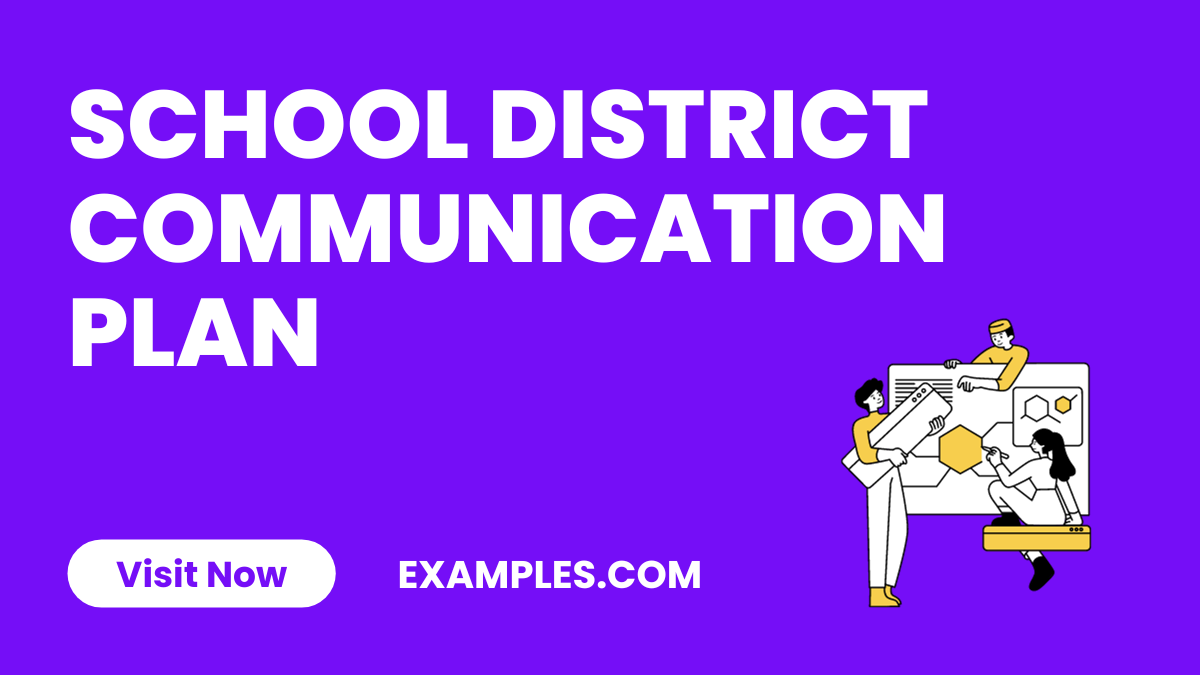5+ School District Communication Plan Examples
Dive into our comprehensive guide on School District Communication Plans, where we illuminate the path to effective educational dialogue. Discover the pivotal role of Parent-teacher communication protocols and innovative Student engagement methods. Our guide, rich with practical Communication Examples, offers insights into crafting strategies that enhance Community involvement and ensure timely Emergency alerts for schools. Embark on a journey to transform your district’s communication landscape and foster a more connected, informed educational community.
Download School District Communication Plan Bundle
School District Communication Plan
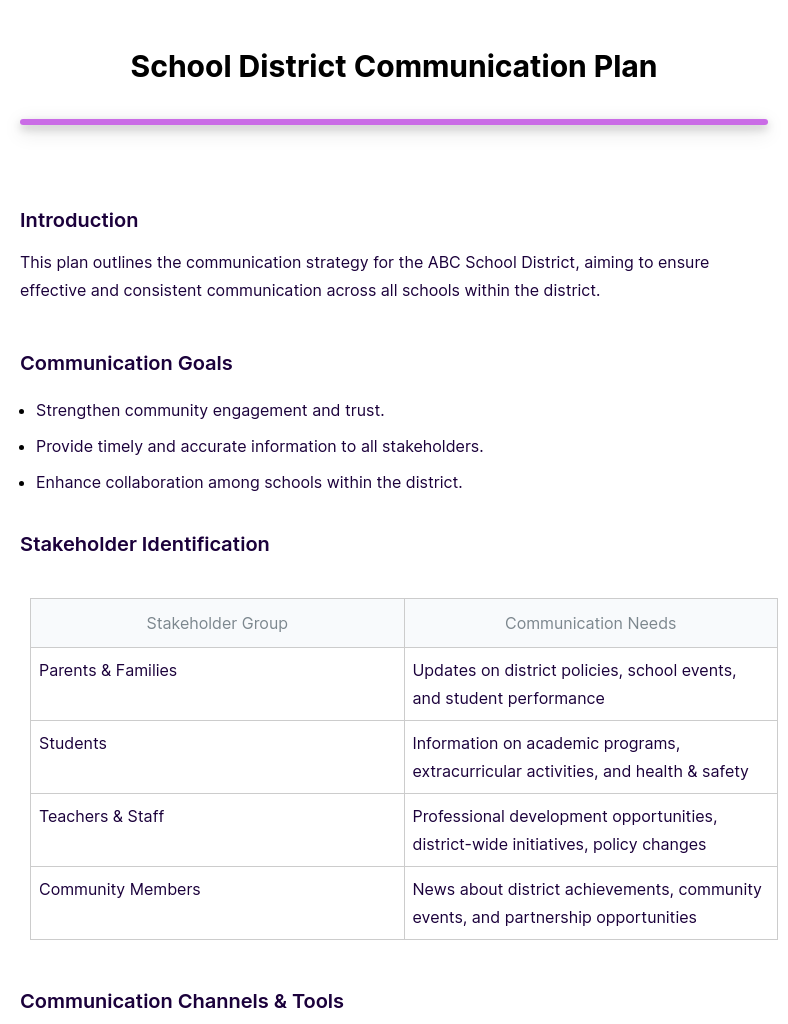
The comprehensive overview of a School District Communication Plan. It outlines the ABC School District’s strategy for effective and consistent communication across schools. Key components include strengthening community engagement, providing accurate information to stakeholders, enhancing collaboration, and identifying the communication needs of various groups such as parents, students, teachers, and the community. The plan details various communication channels and tools, key message areas, and a communication schedule. It emphasizes the importance of feedback, evaluation, and emergency communication protocols, serving as a foundational framework adaptable to any school district’s specific needs.
School District Comprehensive Communication Plan
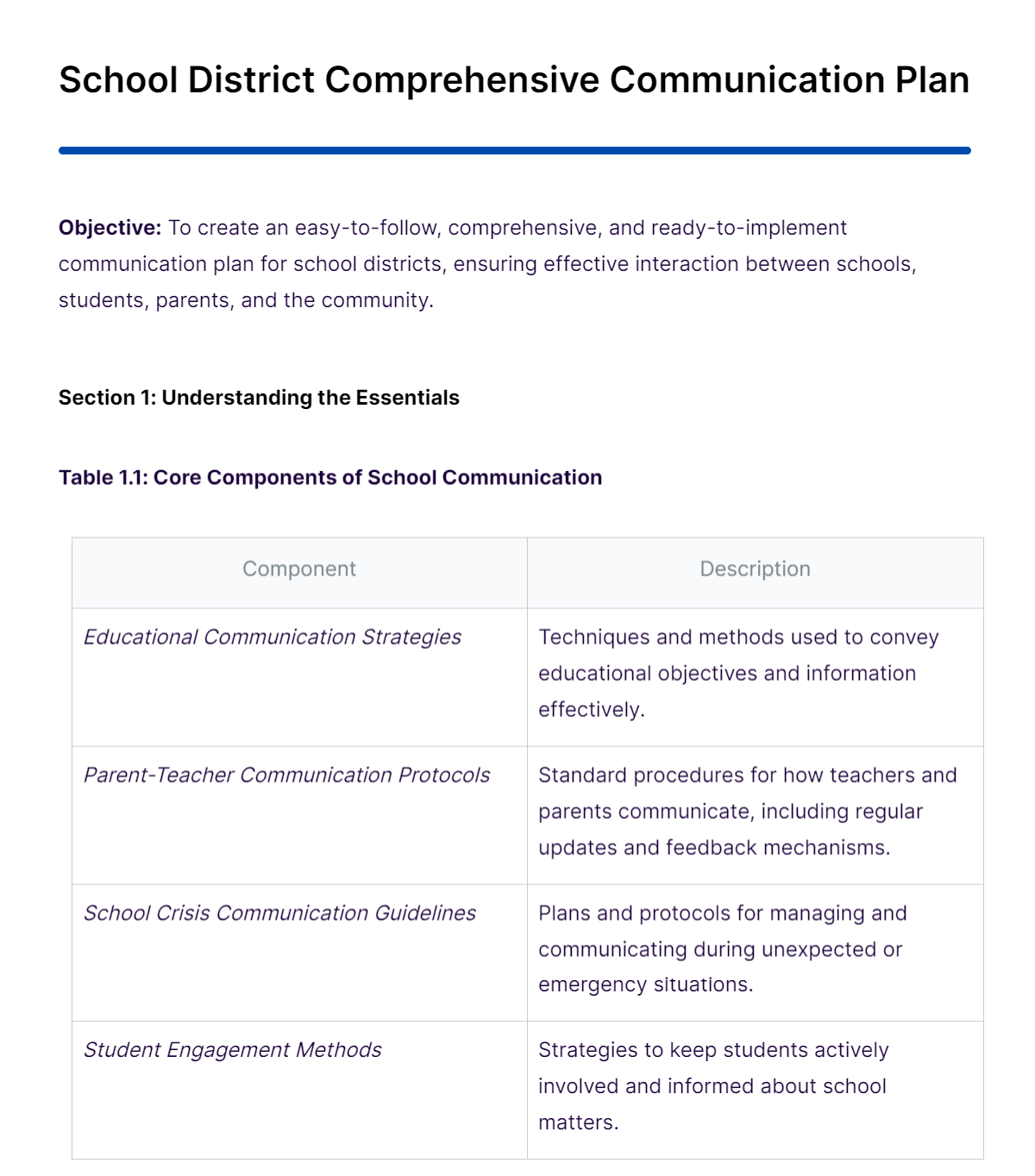
The comprehensive guide on creating a School District Communication Plan. It outlines core components such as educational communication strategies, parent-teacher communication protocols, and crisis management guidelines. The guide details plan development, implementation strategy, monitoring, and evaluation, emphasizing the importance of community involvement, internal communication, and public relations. It also includes resources like templates and tools for various communication plans. This resource serves as a flexible template for school districts to tailor according to their specific needs.
School District Crisis Communication Plan
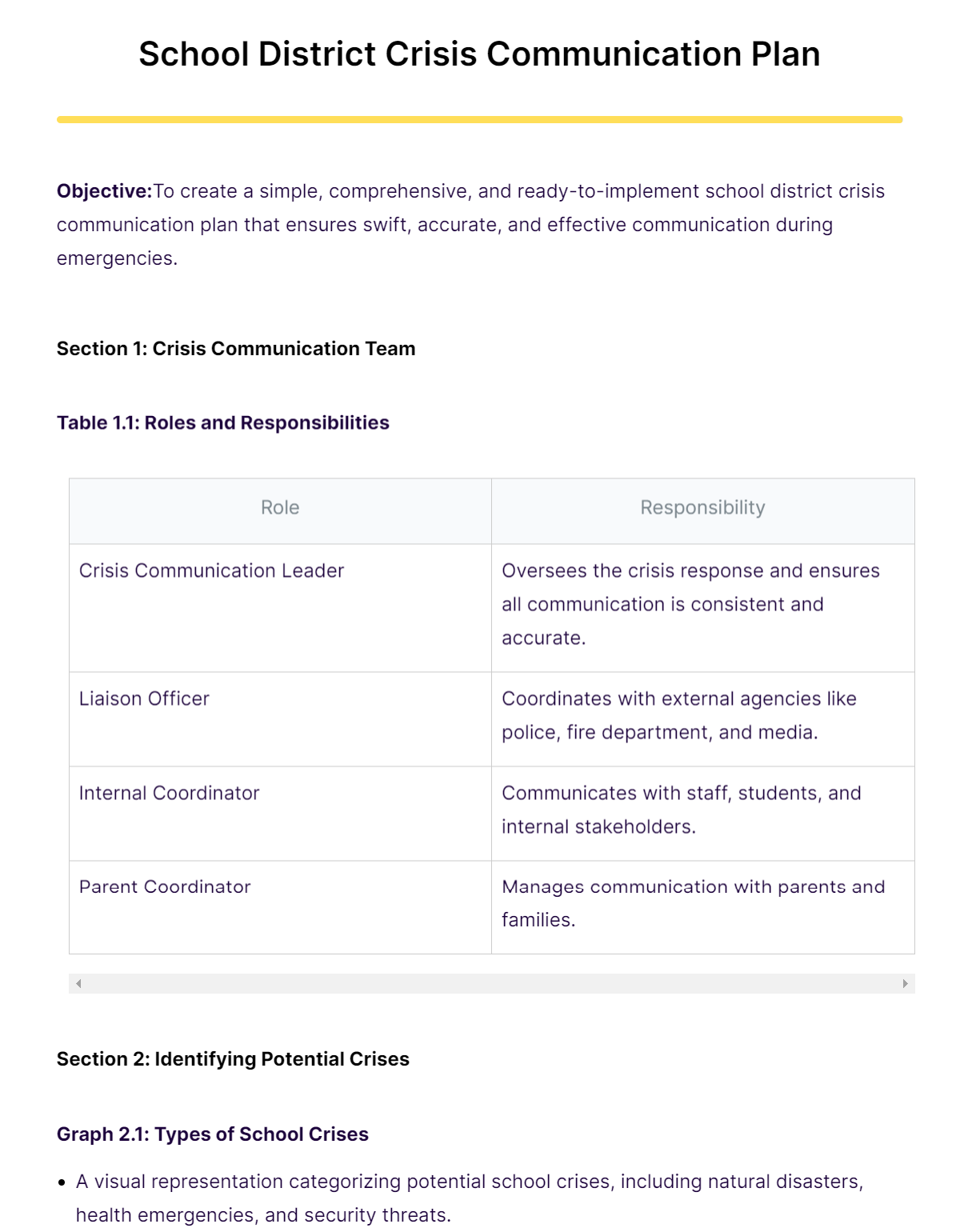
The page on School District Crisis Communication Plan detailed framework for developing an effective crisis communication strategy within a school district. It outlines roles and responsibilities of the crisis communication team, identifies various types of school crises, and provides guidelines for emergency alerts and parent-teacher communication during crises. Additionally, it includes templates for crisis messages and emphasizes the importance of regular training, drills, and updates to the plan. This comprehensive guide serves as a valuable resource for school districts preparing for and managing emergency situations
School District Strategic Communication Plan

eduhsd.k12.ca.us
DownloadCountry School District Communication Plan
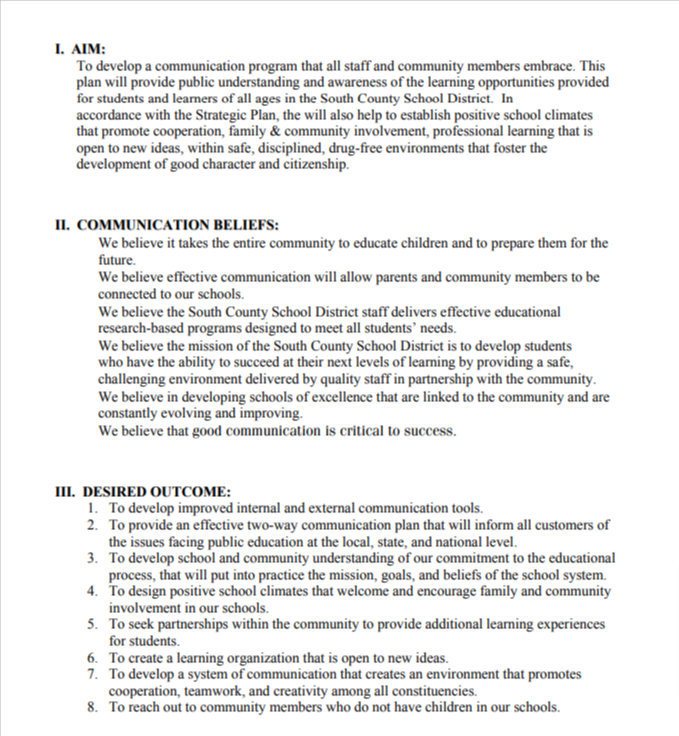
spptap.org
DownloadHow to Create an Effective Communication Plan for Your District?
Developing an effective communication plan for your school district is crucial for fostering a positive educational environment and ensuring stakeholders are well-informed. A strategic School District Communication Plan supports clear and consistent messaging, enhances community relations, and prepares the district for handling various situations effectively.
Assess Your Current Communication Needs and Capabilities
Begin by evaluating your current communication practices. Identify what is working well and areas needing improvement. Assess the tools, channels, and technologies at your disposal and consider how they can be better utilized or updated.
Define Clear Objectives
Establish what you aim to achieve with your communication plan. Objectives might include improving stakeholder engagement, enhancing transparency, or ensuring swift communication during crises. Make sure these goals are Specific, Measurable, Achievable, Relevant, and Time-bound (SMART).
Identify Your Target Audience
Understand the needs and preferences of your key audiences, which typically include students, parents, staff, and the broader community. Segmenting your audience allows for more personalized and effective communication.
Develop Key Messages
Craft clear, concise, and consistent messages that align with your objectives and resonate with your audience. Your messages should reflect the district’s values and mission and address the specific concerns and interests of each audience segment.
Choose Appropriate Communication Channels
Select the most effective channels to reach your audience. These might include email, social media, the district website, newsletters, press releases, public meetings, or traditional media outlets. Consider the strengths and limitations of each channel and how they can be used in combination for maximum impact.
Plan for Crisis Communication
Develop a crisis communication strategy to ensure your district can respond quickly and effectively in emergency situations. This should include predefined channels for rapid information dissemination, templates for public statements, and protocols for internal and external communication.
Allocate Resources
Determine the budget, personnel, and time required to implement your plan. Ensure you have the necessary support and resources to carry out your communication activities effectively.
Implement the Plan
Roll out your communication plan in phases, if necessary. Provide training and support to staff involved in communication efforts and ensure everyone understands their roles and responsibilities.
Monitor, Evaluate, and Adjust
Regularly monitor the effectiveness of your communication efforts and gather feedback from your audience. Evaluate whether you are meeting your objectives and make adjustments as needed. Continuous improvement is key to maintaining an effective communication strategy.
Document and Update Regularly
Keep a detailed record of your communication plan and activities. Regularly review and update the plan to reflect changes in your district’s needs, objectives, and the external environment
Why Does Your District Need a School Communications Plan?
In today’s interconnected world, the importance of a comprehensive Communications Plan for educational districts cannot be overstated. This plan is more than just a set of guidelines; it’s a roadmap for fostering a positive and productive educational environment. Here’s why your district needs one:
Enhancing Parent-Teacher Interactions
A robust School Communications Plan often includes Parent-teacher communication protocols. These protocols ensure that parents are kept in the loop about their child’s academic progress and school events, fostering a collaborative environment that benefits students’ learning experiences.
Streamlining Crisis Management
Schools are not immune to crises, and having a School crisis communication guidelines component in your plan is crucial. It prepares the school community to handle unexpected situations efficiently, minimizing confusion and ensuring student safety.
Boosting Student Engagement
An effective communication plan is not just about disseminating information; it’s also about engaging students. Incorporating Student engagement methods in your plan can lead to a more vibrant and interactive learning atmosphere, encouraging students to participate actively in their education.
Building Community Relationships
Schools are integral parts of their communities. A well-executed plan includes strategies for Community involvement in schools, promoting a sense of belonging and shared responsibility among students, parents, educators, and local stakeholders.
Governing Board Transparency
School board communication policies are a vital component of the plan. These policies ensure that the decisions and actions of the school board are transparent, building trust and accountability within the school community.
Implementing Efficient Announcement Systems
Effective communication in schools includes timely and accurate dissemination of information. An Academic announcements system helps in distributing important academic and extracurricular information to students and staff efficiently.
Improving Public Relations
The reputation of a school district significantly impacts its success. Including School district public relations strategies in your communication plan helps in shaping public perception and promoting the district’s achievements and initiatives.
Enhancing Internal Communication
The heart of a school’s operational efficiency lies in its internal communication. Implementing robust Internal school communication networks ensures that staff and faculty are well-informed and aligned with the district’s goals and policies.
Ensuring Safety Through Emergency Alerts
In times of emergencies, swift communication can be lifesaving. Integrating Emergency alerts for schools into the plan ensures that all members of the school community receive critical information promptly, enhancing the safety and security of students and staff
Communication Plan Strategies for School Districts
Developing effective Communication Plan Strategies for School Districts ensures transparent, consistent, and engaging interaction between schools, students, parents, and the community. This strategy encompasses various methods, from digital newsletters to public forums, aiming to foster an environment of trust and collaboration. Key to success is understanding the diverse needs of the community, leveraging technology for broader reach, and ensuring feedback mechanisms are in place. These plans significantly enhance student outcomes and community involvement.
- Weekly Email Newsletters
- Explanation: Keep parents and staff updated with weekly emails highlighting school news, events, and achievements.
- Sentence Example: “Don’t miss our Science Fair next Wednesday! See the amazing projects our students have been working on.”
- Interactive School Blogs
- Explanation: Share stories, interviews, and educational resources through a regularly updated school blog.
- Sentence Example: “Discover how our 4th graders are learning about renewable energy in our latest blog post.”
- Parent-Teacher Communication Apps
- Explanation: Utilize apps that allow direct and secure communication between teachers and parents.
- Sentence Example: “Your child demonstrated excellent teamwork in class today! Let’s encourage this behavior at home too.”
- Student-Led Video Updates
- Explanation: Empower students to create video updates about school activities and learning experiences.
- Sentence Example: “Tune in to our weekly student news to see what’s happening in and around our school!”
- Public Forums and Q&A Sessions
- Explanation: Host regular public forums for parents and community members to ask questions and provide feedback.
- Sentence Example: “Join us this Thursday for an open discussion about our new literacy program.”
- Social Media Engagement
- Explanation: Use social media platforms to share quick updates, celebrate successes, and promote school events.
- Sentence Example: “We’re proud of our basketball team for their win last night! Check out the highlights on our Facebook page.”
- Multilingual Communication Materials
- Explanation: Provide newsletters, websites, and other communication materials in multiple languages to cater to a diverse community.
- Sentence Example: “Our monthly newsletter is now available in Spanish, French, and three other languages!”
- Emergency Alert Systems
- Explanation: Implement a reliable system for quickly disseminating urgent information to parents and staff.
- Sentence Example: “Please be informed of a 2-hour school delay tomorrow due to severe weather conditions.”
The primary goal of a School District Communication Plan is to create a structured and effective communication framework that supports the educational mission and objectives of the district. This plan aims to enhance connectivity and transparency among all stakeholders within the educational ecosystem. Let’s delve into the key goals of such a plan:
Establishing Clear Communication Channels
The plan aims to establish well-defined communication channels for disseminating information. This includes creating protocols for Internal Communication Plans and External Communication Plans to ensure that the right information reaches the right audience at the right time.
Promoting Stakeholder Engagement
Engaging various stakeholders, including students, parents, teachers, and the community, is a crucial goal. Incorporating strategies like Stakeholder Communication Plans and Community Involvement in Schools initiatives fosters a collaborative environment, enhancing the overall educational experience.
Facilitating Crisis Management
Effective communication is vital during emergencies. Implementing Crisis Communication Plans and Emergency Communication Plans ensures that the district is prepared to respond swiftly and efficiently in crisis situations, prioritizing the safety and well-being of students and staff.
Enhancing Educational Outcomes
A well-crafted communication plan directly impacts students’ learning experiences. By integrating Student Engagement Methods, the plan aims to foster an environment that encourages active learning and academic excellence.
Building Positive Public Relations
An essential goal of the plan is to shape the public perception of the district. Strategies under School District Public Relations help in highlighting the achievements and advancements of the schools, bolstering the district’s reputation.
Supporting Strategic Decision-Making
Effective communication aids in informed decision-making. By incorporating elements like a Comprehensive Communication Plan, the district ensures that all decisions made by the school board and administrators are communicated transparently, fostering trust and accountability.
Ensuring Regulatory Compliance
A comprehensive communication plan also ensures that the district adheres to all relevant educational policies and regulations. This includes updating School Board Communication Policies and maintaining consistent adherence to legal and ethical standards.
Encouraging Continuous Improvement
Finally, the goal of a School District Communication Plan is to create a dynamic environment that supports continuous improvement. Regular evaluations, as outlined in a Communication Evaluation Plan, ensure that the communication strategies remain effective and evolve with the changing needs of the school community.
The Communication Plan of Portland Public Schools emphasizes the importance of effective communication for the district’s success. It aims to align with the district’s mission, vision, and strategic plan, ensuring that stakeholders like school boards, administrators, faculty, staff, parents, students, and the community are well-informed. The plan focuses on delivering consistent communication, using both in-person and online channels, and offers strategies for effective use of these channels. It also highlights the importance of transparency and trust-building between the district and its stakeholders. To explore the complete details of Portland Public Schools’ Communication Plan.



